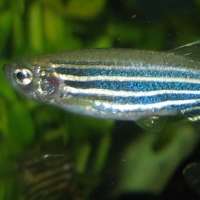Research offers new insight into light detection in vertebrates

Research carried out by scientists from The University of Western Australia, the University of Oxford and University College London will help better understand how light detection works in vertebrates.
The researchers tested zebrafish and found the fish to have more than 40 opsins (proteins that detect light), many more than previously known and the most found in any vertebrate.
The research found opsins in the eye and brain, but also in organs not thought to be directly affected by light, such as the heart, fins, gills, gonads, liver and gut.
Lead author Associate Professor Wayne Davies, Future Fellow from the School of Animal Biology at UWA, who worked with Professor Mark Hankins from the University of Oxford, said the researchers also found four new opsin families (named opn6-9) in zebrafish, amphibians, reptiles, birds and some mammals such as the platypus.
"Some of the photopigments discovered were found to be UV-sensitive and have the potential to assist with functions such as cell DNA repair," he said.
Professor Davies said the findings in the zebrafish could also be applied to other vertebrates that use similar systems to better understand light detection and its effect on the body.
"Light detection that aids vision in vertebrates is well understood, but the impact of light detection on other bodily functions has remained more of a mystery," he said.
"Specialised receptors in vertebrates' eye detect light to assist with colour vision and the formation of images.
"But non-visual systems use light detection in other ways, such as to synchronise biological rhythms for sleep and seasonal breeding."
Professor Davies said mammals use a single type of receptor in the eye which detects light and relays the information to a central "master" clock in the brain, which then regulates bodily functions.
"But in bony fish, cellular clocks are controlled by light directly, bypassing the cranial master control centre," he said.
"In humans, disruption of photosensory systems during activities such as shift-work and long-distance travel can lead to sleep dysfunction and jet-lag, but also to more serious physical and mental health issues, and even death."
Professor Davies said the discoveries in zebrafish would mean researchers could now begin to work out how light controls normal physiology, and assist with future research into diseases found in humans and other animals.
More information: Wayne I.L. Davies et al. An extended family of novel vertebrate photopigments is widely expressed and displays a diversity of function, Genome Research (2015). DOI: 10.1101/gr.189886.115
Journal information: Genome Research
Provided by University of Western Australia

















